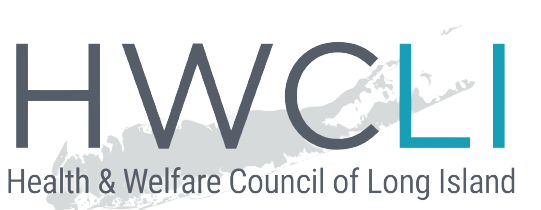
Health Empowerment Alliance of Long Island (HEALI) is Long Island’s Social Care Network, led by Health and Welfare Council of Long Island, and integrates health and social care providers serving Nassau and Suffolk Counties. To join as a CBO partner or to find resources, please click here
Policy & Advocacy
We work with local, state, and federal government partners to advocate for effective policy decisions that will impact our neighbors and hometowns.
Coalitions & Grass Roots Organizing
We bring together nonprofits, business leaders, and lawmakers to discuss solutions to our region’s challenges.
Direct Services
We operate a series of programs that connect Long Islanders with the services they need.
Welcome to the Health & Welfare Council of Long Island
At the Health & Welfare Council of Long Island (HWCLI), our work is to ensure that our region is a welcoming and inclusive place for everyone to live. We can set the standard for what an equitable region looks like. That means safe communities, decent, affordable housing, healthy food, access to care and an opportunity to thrive. In our quest for improvements and systemic change, we face a unique set of obstacles. In fact, the poverty rate today is at its highest since 1959. Given the current assault on the country’s most vulnerable communities, our work is more important than ever.
Our Impact
11350 |
People served in 2023 alone |
76 |
Years Serving Long Island |
200+ |
Partnering Organizations |
Recent News
November 17, 2025
Health summit in Bridgehampton promotes empowerment for women
By Tara Smith
Updated November 15, 2025 7:06 pm
Read on Newsday
Swaddling her newborn son against her chest, Randalle Lewis recounted her terrifying ordeal after being diagnosed with a subchorionic hematoma in the third trimester of her first pregnancy in 2019.
Heavy bleeding prompted Lewis, 37, of Wheatley Heights, to seek care at a hospital emergency room. There, a swarm of health care workers peppered her with questions, dismissing her concerns as they began preparing for an emergency cesarean section.
Lewis, who is the advocacy and coalition manager at the Health & Welfare Council of Long Island and is Black, counts herself lucky that she had a network of family, friends and connections that ultimately spared her from the risky procedure and she had a natural birth instead.
The traumatic experience is what led Lewis to opt for a midwife and doula during her most recent pregnancy.
“I educated myself, and it wasn’t easy work. But whatever the thing is that you want, whatever the thing is that’s bothering you, do your research, use your resources and ask questions,” Lewis told more than 50 women who gathered for a summit on women’s health in Bridgehampton, where she was a speaker Saturday.
Turning reluctance and mistrust into education and empowerment for women, particularly women of color, was a key theme of Saturday’s conference at the Bridgehampton Child Care & Recreational Center. The event was co-hosted by the center, the health and welfare council and the Women’s Diversity Network.
Wide-ranging panel discussions focused on women’s health at every stage, blending candid, lived experiences with insights from medical experts throughout the region. Though maternal mortality rates have improved, racial disparities still exist.
Data from the state Department of Health shows Black women are five times more likely than white women to die from pregnancy-related conditions, including excessive bleeding, blood clots and high blood pressure.
Between 2018 and 2020, the statewide maternal mortality rate was 18.5 per 100,000 live births. Among Black women, the rate was 54.7, compared with 11.2 for white women.
“We know there is a history of racial injustice, social structural barriers, the fact that women of color are not listened to,” said panelist Adesuwa Watson, director of the Suffolk County Office of Minority Health. “Our symptoms are trivialized.”
Watson said the county organization focuses on conditions that disproportionately affect communities of color but specifically called for more inclusive medical trials, which could improve health outcomes.
Doctors who were serving as panelists at the conference, agreed, adding that implicit biases and what is taught in medical books can negatively impact patient care and contribute to disparities.
“I only know what eczema looks like on Black skin because of my family,” said Dr. Lucy Moussignac, a Sag Harbor-based physician.
Many providers, who were panelists, said their organizations have added training on implicit bias to help provide more equitable care.
Disparities in health care don’t just impact expectant mothers. Panelists spoke about a range of socioeconomic and cultural barriers that can affect how other issues, from fertility to heart and gum disease and Alzheimer’s disease, are treated, let alone diagnosed.
Women’s Diversity Network founder Shanequa Levin said it’s important to be honest about health care experiences, even if taboo or uncomfortable, to promote changes “so that women in every stage of life, in every ZIP code and every background, cannot only survive but thrive.”
November 1, 2025
Health care sticker shock as Affordable Care Act enrollment begins
By David Olson
Updated November 1, 2025 9:43
Read on Newsday
Long Islanders signing up for health insurance through the Affordable Care Act beginning Saturday may suffer sticker shock, with some monthly premiums reaching thousands of dollars and no sign of an agreement on extending federal subsidies in sight.
Open enrollment on the New York State Department of Health’s ACA marketplace begins Nov. 1 for new enrollees and Nov. 16 for renewals.
About 28,000 Long Islanders currently receive a federal tax credit to help pay for their insurance. A 2021 law increased the amount of government assistance, but those enhanced subsidies are set to expire Dec. 31. Small-business owners and employees and independent contractors are among those who have ACA insurance.
If the subsidies are not extended, “The choice people will be making is between health insurance and groceries, or health insurance and their mortgage,” said Vanessa Baird-Streeter, president and CEO of the nonprofit Health and Welfare Council of Long Island, which assists people with signing up for the ACA.
“People are very much worried” about losing coverage, said Baird-Streeter, including middle-income people who struggle to afford insurance on high-cost Long Island.
Democrats have refused to vote for a government spending bill unless the enhanced subsidies are made permanent. That has kept the government shut down since Oct. 1. Some Republicans oppose extending the subsidies while others say the issue should be resolved outside the shutdown.
Even if subsidies eventually are extended, Cynthia Cox, director of the ACA program for the nonprofit health policy group KFF, worries that many people will take one look at high premiums and not give the ACA another chance.
“Once a person decides something is too expensive, it takes a lot of convincing to get them to come back look again,” she said.
Anyone signing up for new ACA coverage can find out starting Saturday how much they’ll pay without subsidies.
New Yorkers currently with ACA coverage can get estimates for how much their subsidies will decrease, but it won’t be until renewals begin on Nov. 16 that they will see exactly what their new policies would cost, Cassaundra Howell, chief operating officer of the nonprofit Public Health Solutions, said in an email.
The average premium increase for Long Islanders with subsidized plans would be 32%, the state estimates.
A KFF online calculator shows that a family of four in Suffolk with an annual household income of $130,000 would, if the subsidies are extended, receive an estimated monthly federal tax credit of $1,514. That would mean an estimated premium for a mid-tier “silver plan” would cost $921 a month. But they would be ineligible for any government help if the enhanced subsidies are not extended and would instead pay an estimated $2,435 monthly premium.
An individual in Nassau earning $45,000 a year has a low enough income to still qualify for subsidies even if the enhanced credits aren’t extended. But the cost for a silver plan would rise from $206 a month to $359. That person currently pays a $0 premium for a bronze plan and would pay $143 if subsidies are not extended. Bronze plans, though, have higher deductibles and co-pays.
Rep. Laura Gillen (D-Rockville Centre) said in a statement that she has “heard from many Nassau County residents concerned that their premiums are set to skyrocket. … [Republicans'] refusal to extend these credits, which only legal residents are eligible for, will worsen the cost-of-living crisis on Long Island. I will continue fighting for both sides to work together to preserve these tax credits.”
Rep. Nick LaLota (R-Amityville) supports extending the subsidies for a year but has called on the shutdown to end.
“Americans need real solutions to rising health care costs, as since the enactment of Obamacare, premiums have grown 60% faster than inflation even while one in three claims are denied and insurance companies post record profits,” he said in a statement.
The drop in subsidies could be deadly for some, Michael Davoli, New York senior government relations director for the American Cancer Society’s Cancer Action Network, said in a statement.
“These increases will put quality, affordable coverage out of reach for many New Yorkers,” he said. “For cancer patients in active treatment and who may face a cancer diagnosis in the future, a loss of coverage would be life-threatening.”
October 31, 2025
Introducing Long Island Business Influencers: Top 100 Long Islanders | Long Island Business News
By LIBN Staff
Posted on October 31st, 2025
Read on LIBN
Previously known as Most Influential Long Islanders, this year’s section was renamed Top 100 Long Islanders to reflect the breadth of talent and uniquely special region that we have, as well as those who strive make Long Island the best place to live, work and socialize.
Long Island’s economic vitality and community strength are defined by these visionaries who lead with purpose, innovation and an unwavering commitment to the region we call home. This year’s Top 100 Influencers represent the diverse tapestry of leadership that makes Long Island a dynamic place to live, work and grow.
From real estate developers transforming our skyline to nonprofit leaders addressing critical social needs, from financial institutions championing economic inclusion to entrepreneurs building tomorrow’s industries, these individuals share a common thread: they are invested in Long Island’s future. Their influence extends far beyond their corporate offices and boardrooms, reaching into our downtowns, communities and the lives of countless residents.
What distinguishes this year’s honorees is not merely their professional achievements, but their deep-rooted commitment to civic engagement. Many serve on nonprofit boards, mentor the next generation of leaders, advocate for smart growth and affordable housing, and champion causes that strengthen our social fabric. They understand that true leadership means building something larger than themselves—whether it’s creating pathways to stability for veterans, expanding access to healthcare, revitalizing Main Street corridors, or developing sustainable communities.
These leaders have weathered economic challenges, adapted to changing markets, and emerged stronger. They’ve championed innovation while honoring tradition, pursued growth while maintaining integrity, and achieved success while lifting others along the way. Their decades of combined experience—spanning finance, real estate, healthcare, education, technology and beyond—represent an invaluable resource for our region.
As you read through these profiles, you’ll discover the stories behind Long Island’s most influential voices. These are the men and women shaping policy, driving economic development, and ensuring that Long Island remains a place where businesses thrive and communities flourish. Their leadership today is building the Long Island of tomorrow.
Check out the HWCLI Staff and Board of Directors' profiles:
Click here for Vanessa Baird-Streeter, President and CEO.
Click here for Sammy Chu, HWCLI Board Member.
Click here for Corinne Hammons, HWCLI Board Member.
Click here for Timothy E. Sams, HWCLI Board Member.
Events
Join us in creating a future for Long Island in which everyone has an equal opportunity to prosper and thrive.
Join Our Network
Subscribe to Our Newsletter
Copyright ©2025 HWCLI. All Rights Reserved. Designed by FBC
























